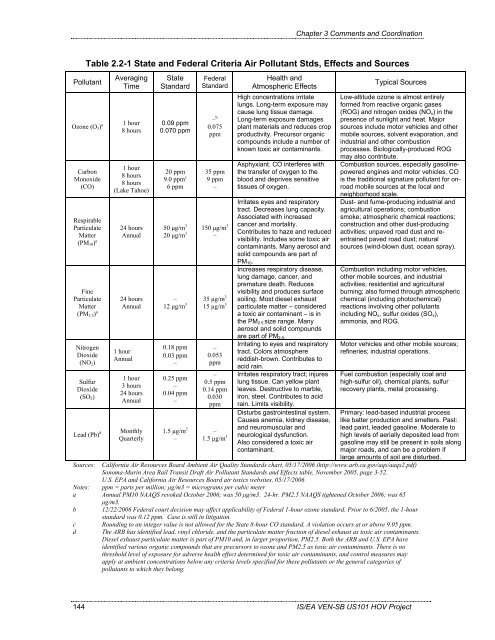Chapter 1 - Caltrans - State of California
Chapter 1 - Caltrans - State of California
Chapter 1 - Caltrans - State of California
You also want an ePaper? Increase the reach of your titles
YUMPU automatically turns print PDFs into web optimized ePapers that Google loves.
<strong>Chapter</strong> 3 Comments and Coordination<br />
Table 2.2-1 <strong>State</strong> and Federal Criteria Air Pollutant Stds, Effects and Sources<br />
Pollutant<br />
Ozone (O3) a<br />
Carbon<br />
Monoxide<br />
(CO)<br />
Respirable<br />
Particulate<br />
Matter<br />
(PM10) a<br />
Fine<br />
Particulate<br />
Matter<br />
(PM2.5) a<br />
Nitrogen<br />
Dioxide<br />
(NO2)<br />
Sulfur<br />
Dioxide<br />
(SO2)<br />
Lead (Pb) d<br />
Averaging<br />
Time<br />
1 hour<br />
8 hours<br />
1 hour<br />
8 hours<br />
8 hours<br />
(Lake Tahoe)<br />
24 hours<br />
Annual<br />
24 hours<br />
Annual<br />
1 hour<br />
Annual<br />
1 hour<br />
3 hours<br />
24 hours<br />
Annual<br />
Monthly<br />
Quarterly<br />
<strong>State</strong><br />
Standard<br />
0.09 ppm<br />
0.070 ppm<br />
20 ppm<br />
9.0 ppm c<br />
6 ppm<br />
50 µg/m 3<br />
20 µg/m 3<br />
–<br />
12 µg/m 3<br />
0.18 ppm<br />
0.03 ppm<br />
–<br />
0.25 ppm<br />
–<br />
0.04 ppm<br />
–<br />
1.5 µg/m 3<br />
–<br />
Federal<br />
Standard<br />
– b<br />
0.075<br />
ppm<br />
35 ppm<br />
9 ppm<br />
–<br />
150 µg/m 3<br />
–<br />
35 µg/m 3<br />
15 µg/m 3<br />
–<br />
0.053<br />
ppm<br />
–<br />
0.5 ppm<br />
0.14 ppm<br />
0.030<br />
ppm<br />
–<br />
1.5 µg/m 3<br />
Health and<br />
Atmospheric Effects<br />
High concentrations irritate<br />
lungs. Long-term exposure may<br />
cause lung tissue damage.<br />
Long-term exposure damages<br />
plant materials and reduces crop<br />
productivity. Precursor organic<br />
compounds include a number <strong>of</strong><br />
known toxic air contaminants.<br />
Asphyxiant. CO interferes with<br />
the transfer <strong>of</strong> oxygen to the<br />
blood and deprives sensitive<br />
tissues <strong>of</strong> oxygen.<br />
Irritates eyes and respiratory<br />
tract. Decreases lung capacity.<br />
Associated with increased<br />
cancer and mortality.<br />
Contributes to haze and reduced<br />
visibility. Includes some toxic air<br />
contaminants. Many aerosol and<br />
solid compounds are part <strong>of</strong><br />
PM10.<br />
Increases respiratory disease,<br />
lung damage, cancer, and<br />
premature death. Reduces<br />
visibility and produces surface<br />
soiling. Most diesel exhaust<br />
particulate matter – considered<br />
a toxic air contaminant – is in<br />
the PM2.5 size range. Many<br />
aerosol and solid compounds<br />
are part <strong>of</strong> PM2.5.<br />
Irritating to eyes and respiratory<br />
tract. Colors atmosphere<br />
reddish-brown. Contributes to<br />
acid rain.<br />
Irritates respiratory tract; injures<br />
lung tissue. Can yellow plant<br />
leaves. Destructive to marble,<br />
iron, steel. Contributes to acid<br />
rain. Limits visibility.<br />
Disturbs gastrointestinal system.<br />
Causes anemia, kidney disease,<br />
and neuromuscular and<br />
neurological dysfunction.<br />
Also considered a toxic air<br />
contaminant.<br />
Typical Sources<br />
Low-altitude ozone is almost entirely<br />
formed from reactive organic gases<br />
(ROG) and nitrogen oxides (NOx) in the<br />
presence <strong>of</strong> sunlight and heat. Major<br />
sources include motor vehicles and other<br />
mobile sources, solvent evaporation, and<br />
industrial and other combustion<br />
processes. Biologically-produced ROG<br />
may also contribute.<br />
Combustion sources, especially gasolinepowered<br />
engines and motor vehicles. CO<br />
is the traditional signature pollutant for onroad<br />
mobile sources at the local and<br />
neighborhood scale.<br />
Dust- and fume-producing industrial and<br />
agricultural operations; combustion<br />
smoke; atmospheric chemical reactions;<br />
construction and other dust-producing<br />
activities; unpaved road dust and reentrained<br />
paved road dust; natural<br />
sources (wind-blown dust, ocean spray).<br />
Combustion including motor vehicles,<br />
other mobile sources, and industrial<br />
activities; residential and agricultural<br />
burning; also formed through atmospheric<br />
chemical (including photochemical)<br />
reactions involving other pollutants<br />
including NOx, sulfur oxides (SOx),<br />
ammonia, and ROG.<br />
Motor vehicles and other mobile sources;<br />
refineries; industrial operations.<br />
Fuel combustion (especially coal and<br />
high-sulfur oil), chemical plants, sulfur<br />
recovery plants, metal processing.<br />
Primary: lead-based industrial process<br />
like batter production and smelters. Past:<br />
lead paint, leaded gasoline. Moderate to<br />
high levels <strong>of</strong> aerially deposited lead from<br />
gasoline may still be present in soils along<br />
major roads, and can be a problem if<br />
large amounts <strong>of</strong> soil are disturbed.<br />
Sources: <strong>California</strong> Air Resources Board Ambient Air Quality Standards chart, 05/17/2006 (http://www.arb.ca.gov/aqs/aaqs2.pdf)<br />
Sonoma-Marin Area Rail Transit Draft Air Pollutant Standards and Effects table, November 2005, page 3-52.<br />
U.S. EPA and <strong>California</strong> Air Resources Board air toxics websites, 05/17/2006<br />
Notes: ppm = parts per million; µg/m3 = micrograms per cubic meter<br />
a Annual PM10 NAAQS revoked October 2006; was 50 µg/m3. 24-hr. PM2.5 NAAQS tightened October 2006; was 65<br />
µg/m3.<br />
b 12/22/2006 Federal court decision may affect applicability <strong>of</strong> Federal 1-hour ozone standard. Prior to 6/2005, the 1-hour<br />
standard was 0.12 ppm. Case is still in litigation.<br />
c Rounding to an integer value is not allowed for the <strong>State</strong> 8-hour CO standard. A violation occurs at or above 9.05 ppm.<br />
d The ARB has identified lead, vinyl chloride, and the particulate matter fraction <strong>of</strong> diesel exhaust as toxic air contaminants.<br />
Diesel exhaust particulate matter is part <strong>of</strong> PM10 and, in larger proportion, PM2.5. Both the ARB and U.S. EPA have<br />
identified various organic compounds that are precursors to ozone and PM2.5 as toxic air contaminants. There is no<br />
threshold level <strong>of</strong> exposure for adverse health effect determined for toxic air contaminants, and control measures may<br />
apply at ambient concentrations below any criteria levels specified for these pollutants or the general categories <strong>of</strong><br />
pollutants to which they belong.<br />
144 IS/EA VEN-SB US101 HOV Project

















